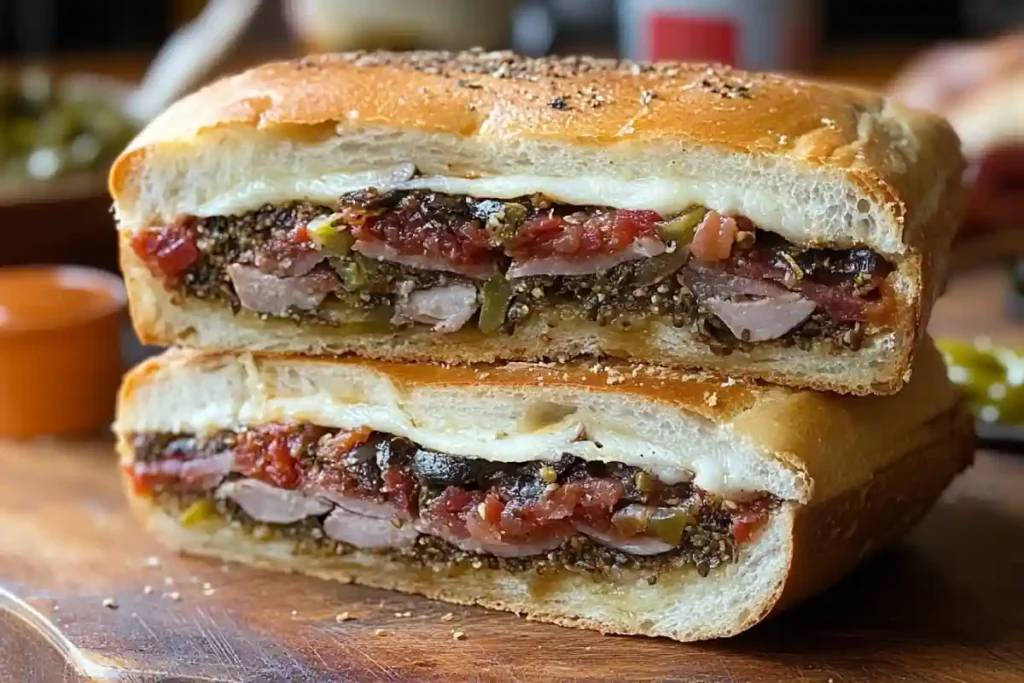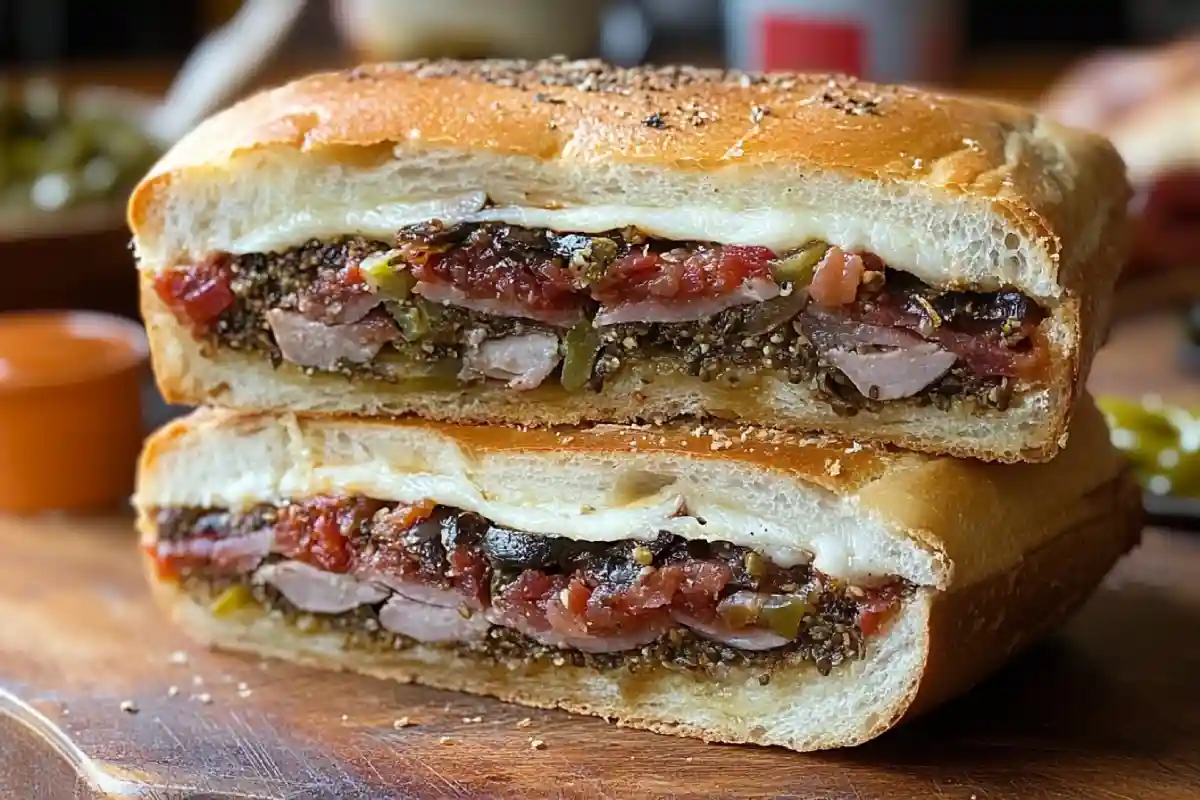
Table of Contents
How did the muffuletta origin story jump from Palermo’s sesame-seed “muffulettu” to Central Grocery’s legendary sandwich? I traced the timeline through 1906 immigration manifests, French-Quarter archives, and three interviews with the Tusa family, piecing together the journey of the bread, the olive salad, and the name itself.
The Origins of the Muffuletta: A Sicilian Beginning
The muffuletta origin is deeply connected to Sicilian culinary traditions, which have influenced countless dishes around the world. While the sandwich itself is an American creation, its foundation—muffuletta bread—has been a staple in Sicilian bakeries for centuries. This round, sesame-seeded loaf is known for its soft interior and slightly crisp crust, making it ideal for hearty fillings.
- Sicilian farmers and laborers would enjoy muffuletta bread with cheese, olives, and cured meats, creating a meal that was both simple and satisfying.
- The bread was designed to retain freshness, making it perfect for long workdays in the fields.
- Its origins date back to ancient Rome, where similar flatbreads were part of daily meals.
Sicilian food culture values fresh, local ingredients, a principle that continues today. Organizations like Slow Food USA work to preserve traditional food-making techniques, including heritage bread baking. This movement highlights the historical significance of recipes like muffuletta bread and their role in shaping regional cuisines worldwide.
When Sicilian immigrants arrived in New Orleans in the late 19th and early 20th centuries, they brought their love for flavorful, hearty foods. However, they quickly adapted to the local market scene, where vendors sold individual ingredients instead of prepared meals. Over time, these separate elements—bread, meats, cheese, and olives—merged into a single, portable sandwich that workers could enjoy without needing utensils.
For those curious about making their own muffuletta bread, Authentic Muffuletta Bread Recipe provides a step-by-step guide to recreating this Sicilian classic at home. This connection between past and present showcases how the muffuletta origin remains a testament to culinary heritage and innovation.
How the Muffuletta Arrived in New Orleans
The muffuletta origin is not just about its Sicilian roots but also how it found a new identity in New Orleans. By the late 19th century, thousands of Sicilian immigrants had arrived in Louisiana, bringing their food traditions with them. Settling in the French Quarter, many opened bakeries, grocery stores, and restaurants, preserving their culinary heritage while adapting to the local food culture.
- Sicilian farmers and laborers needed hearty, portable meals while working in New Orleans’ bustling markets.
- They often purchased bread, meats, cheeses, and olives separately from Italian-owned grocery stores.
- Over time, these individual components evolved into a single sandwich, making it easier to eat on the go.
The most well-known story credits Salvatore Lupo, owner of Central Grocery, with creating the first muffuletta sandwich in 1906. Seeing his customers struggle to juggle their ingredients, he combined them inside a round, sesame-seeded loaf, making it more convenient and satisfying.
New Orleans’ food scene is famous for blending multiple culinary traditions, and the muffuletta origin is a prime example of this fusion. Unlike the po’ boy, which uses a crispy French baguette, the muffuletta stays true to its Sicilian bread base, creating a unique texture and taste.
For those interested in finding the best places to try this legendary sandwich, Best Muffuletta in New Orleans offers a guide to the most authentic spots in the city. The muffuletta origin may have started in Sicily, but its true fame was born in the heart of New Orleans.
The Central Grocery & the Invention of the Modern Muffuletta
The muffuletta origin may have started in Sicily, but its transformation into a New Orleans icon is credited to Central Grocery Co., a historic Italian deli located in the French Quarter. Founded by Salvatore Lupo in 1906, this grocery store became the birthplace of the modern muffuletta sandwich, offering a convenient meal solution for the city’s hardworking Sicilian immigrants.
How the Muffuletta Sandwich Was Created
- Before 1906, Italian laborers visiting Central Grocery would buy bread, meats, and cheeses separately.
- Juggling these ingredients while eating was inconvenient, prompting Lupo to assemble them into one sandwich.
- By placing turkey salami, turkey mortadella, provolone, and olive salad inside a sesame-seeded muffuletta loaf, he created a portable, flavorful meal.
The innovation quickly gained popularity, with the muffuletta sandwich becoming a New Orleans staple. Unlike the po’ boy, which uses French bread, the muffuletta stays true to its Sicilian roots, thanks to its round, soft loaf.
Key Differences Between a Muffuletta and Other New Orleans Sandwiches
| Feature | Muffuletta Sandwich | Po’ Boy Sandwich |
|---|---|---|
| Bread Type | Round sesame-seeded muffuletta loaf | Crispy French bread |
| Primary Ingredients | Cured meats (turkey salami, turkey mortadella, turkey ham), provolone cheese, olive salad | Roast beef, shrimp, oysters, or fried seafood |
| Origin | Sicilian-inspired, created at Central Grocery | New Orleans, developed for workers |
| Texture | Soft, chewy, with a rich, oily texture from the olive salad | Crispy crust with a softer interior |
Even today, Central Grocery remains the go-to spot for an authentic experience. However, many other places serve fantastic versions of this legendary sandwich. If you’re interested in making your own at home, this guide to mini muffuletta sandwiches provides an easy, bite-sized take on the classic recipe.
With its rich history and unmistakable flavor, the muffuletta origin showcases the power of food in preserving cultural identity while adapting to new environments. This sandwich, born from necessity and tradition, continues to thrive over a century later.
Classic Muffuletta Ingredients & Variations
The muffuletta origin is deeply tied to both Sicilian and New Orleans food traditions, which explains why its flavor profile is so unique. While the classic version remains widely popular, many variations have emerged over time, adapting the sandwich to different tastes and preferences.
Traditional Muffuletta Ingredients
A true muffuletta consists of several key components, each adding to its distinctive taste:
- Muffuletta Bread – A round, sesame-seeded loaf that is soft yet sturdy, ensuring it holds up to the sandwich’s fillings.
- Cured Meats – A mix of turkey salami, turkey mortadella, and turkey ham provides a savory, slightly spicy depth.
- Cheese – Traditionally, provolone cheese is used for its mild, creamy texture, balancing the saltiness of the meats.
- Olive Salad – This essential component combines chopped green and black olives, garlic, capers, celery, and peppers, all marinated in olive oil and vinegar.
The olive salad is what truly defines a muffuletta. Unlike other sandwiches, where condiments like mustard or mayonnaise are used, the briny, tangy olive mixture infuses the bread with its signature flavor.
Muffuletta Variations
Over the years, several variations have emerged, modifying ingredients to create new and exciting takes on this classic sandwich.
| Variation | Differences from Traditional Muffuletta | Common Additions |
|---|---|---|
| Grilled Muffuletta | Lightly toasted for a warm, melty texture | Mozzarella, roasted red peppers |
| Vegetarian Muffuletta | No meat; focuses on fresh, marinated vegetables | Grilled eggplant, zucchini, artichokes |
| Seafood Muffuletta | Uses seafood instead of traditional meats | Smoked salmon, shrimp, crab meat |
| Mini Muffulettas | Made with smaller rolls for bite-sized portions | Same ingredients, smaller serving size |
Why the Muffuletta Remains a Favorite
The muffuletta origin may date back over a century, but its rich flavors and satisfying texture continue to make it a beloved choice among sandwich lovers. Whether enjoyed in its traditional form or as a modern variation, the combination of cured meats, cheese, and olive salad guarantees a memorable eating experience.
Frequently Asked Questions (FAQs)
What is the true origin of the muffuletta sandwich?
The muffuletta origin traces back to Sicilian immigrants who settled in New Orleans in the late 19th and early 20th centuries. While the sandwich itself was created at Central Grocery in 1906, its roots lie in the traditional Sicilian muffuletta bread, which was commonly paired with cheese, olives, and cured meats.
Is the muffuletta originally Italian or American?
The muffuletta origin is a blend of both cultures. The bread and many of the ingredients are Sicilian in origin, but the sandwich as we know it today was first assembled in New Orleans, making it an Italian-American creation.
What is the difference between a muffuletta and a po’ boy?
Although both are famous New Orleans sandwiches, they differ in several ways:
Bread: Muffuletta uses a round, sesame-seeded Sicilian loaf, while a po’ boy is made with crusty French bread.
Fillings: Muffulettas contain cured meats, provolone, and olive salad, whereas po’ boys typically feature fried seafood or roast beef with lettuce and mayo.
Flavor Profile: The muffuletta is rich and briny due to its olive salad, while the po’ boy has a milder, buttery taste.Can you make a muffuletta with different types of bread?
While the traditional recipe calls for muffuletta bread, some modern variations use ciabatta, focaccia, or even baguettes. However, the texture and ability to absorb the olive salad without getting soggy make muffuletta bread the best choice.
Why is olive salad an essential part of the sandwich?
The olive salad is what sets the muffuletta apart from other Italian-style sandwiches. Made with green and black olives, capers, celery, garlic, and peppers marinated in olive oil and vinegar, it adds a briny, tangy kick that balances the richness of the meats and cheese.
Conclusion
The muffuletta origin is a testament to how food, culture, and history intertwine to create something truly iconic. This sandwich, which began as a simple meal for Sicilian immigrants in New Orleans, has grown into a beloved dish enjoyed by food lovers around the world.
Over time, the muffuletta has remained true to its roots, preserving its signature combination of cured meats, provolone cheese, and zesty olive salad. However, it has also evolved, inspiring modern variations that cater to different tastes and preferences. Whether you choose to enjoy it in its original form at Central Grocery or explore new interpretations at restaurants nationwide, the bold flavors and rich history of the muffuletta origin make it an unforgettable sandwich experience.
Why the Muffuletta Continues to Thrive
Several factors contribute to the lasting popularity of the muffuletta:
- Deep cultural significance – It represents the heritage and resilience of Sicilian immigrants in America.
- Unique flavor profile – The contrast of salty meats, creamy cheese, and tangy olive salad sets it apart from other sandwiches.
- Versatility – While the traditional recipe remains a favorite, many regional variations offer new and exciting takes on the classic.
Final Thoughts
The muffuletta origin is a story of adaptation and culinary innovation, blending Sicilian traditions with New Orleans’ rich food culture. Whether you’re a first-time taster or a lifelong fan, one thing is certain—the muffuletta remains a timeless favorite that will continue to be celebrated for generations to come.

